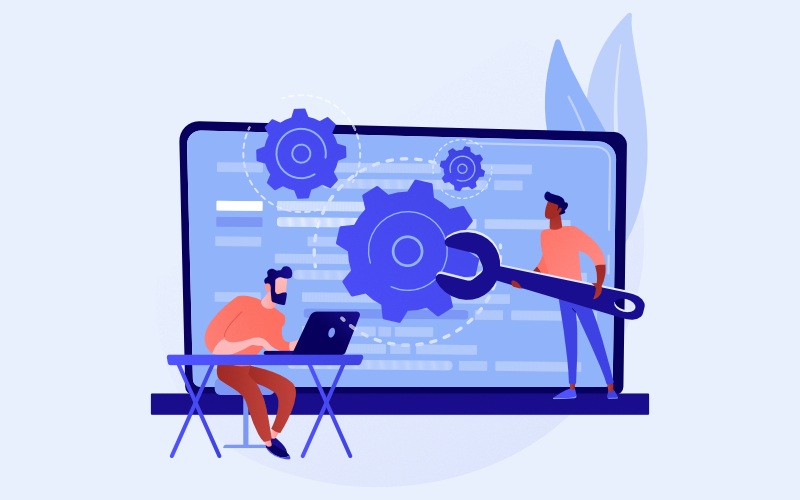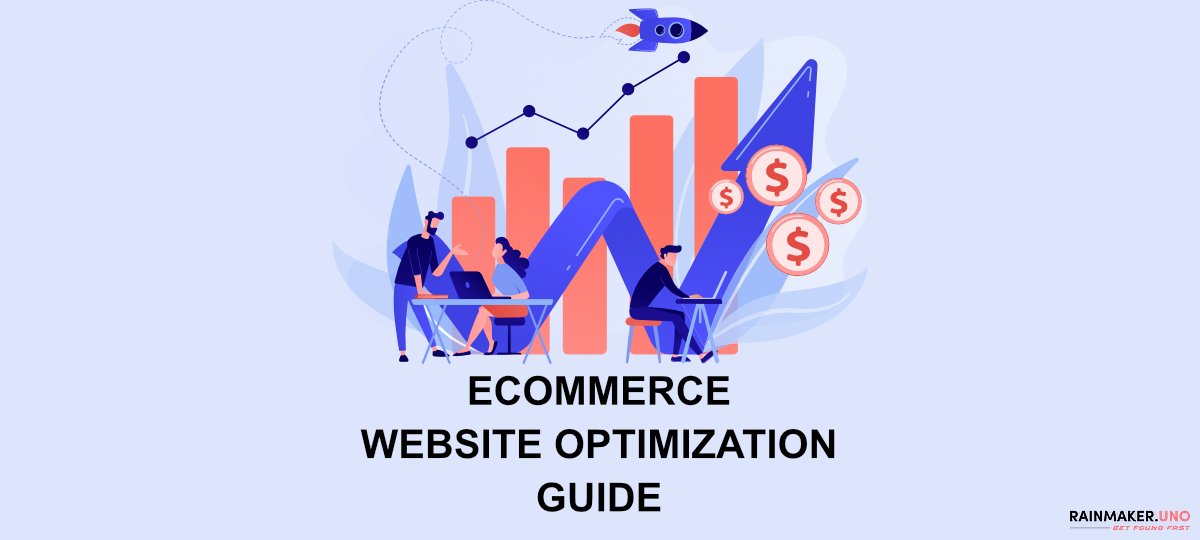Enhancing sales through an eCommerce store is not a leisurely task. Some might even say it is significantly more intricate than promoting brick-and-mortar stores. For your sales to take a positive shift, you need to sustain your website in favor of the emerging sales trends. Business owners need to implement ingenious tips, countless processes, and cutting-edge strategies to optimize their eCommerce website’s conversion rate these days.
Merchants have to optimize their website by improving their SEO ranking, generating high-quality audio and video content, increasing social media awareness, etc. Sellers are required to follow numerous rules and regulations to improve their website’s conversion and transaction rates.
eCommerce owners underestimate the power of modifying their existing website optimization strategies. Research has shown that making minor tweaks to your website results in 50% increased sales. Marketers should be aware of the changes they need to make, as modifying the wrong elements could hurt your website. This guide will aid you in understanding the core concept of eCommerce website optimization and tips for improvements.
What is eCommerce Website Optimization?
eCommerce website optimization is an efficient way of enhancing your site to increase the chances of converting potential clients to buyers. The primary goal of creating a website for your eCommerce page is to persuade visitors to shop from you. Each aspect of your website – such as product descriptions, navigation, check-out process, content, themes, layouts – is deliberately curated to foster conversion. However, the consumer conversion rate is tricky, and it is always challenging to understand what and how to alter things without undergoing a detailed CRO audit.

According to a recent survey, about 71% of shoppers believe they will get cheaper deals online than physical stores. Even with the favorable statistics, it is still an arduous task to sell your products online. That is why vendors optimize their eCommerce websites to encourage customers to buy online.
eCommerce product page optimization is entirely different from basic website optimization as the transactions and conversions happen all in one place, exactly like in retail stores. Naturally, this denotes an altogether different and specific set of rules, regulations, and practices to increase conversion rates.
Why is SEO Important for eCommerce?
eCommerce businesses thrive by being easily accessible to the targeted audience. Fetching traffic for eCommerce sites is dramatically different from getting customers to visit your traditional stores. Consumers need to see your store or experience its scope to buy from your product range and ultimately enhance sales.
A well-designed website paired with top-level optimized content will rank on prominent search engines like Google, Yahoo, etc. Furthermore, it makes acquiring leads and higher conversion rates easier. SEO services for eCommerce website optimization is a laborious and challenging process, but you could always hire professionals to help you with the journey.
SEO Audits

Tips to Boost eCommerce Website Optimization
Enhance Your On-page SEO Elements
1. Use High-quality Product Images
2. Introduce Engaging Content
- Uniqueness: This factor demonstrates the authenticity of your article. It is easy to refer to content from the internet and curate plagiarized free articles. But, you have to ensure that your content contributes something unique or fresh amidst a wide array of articles already written about the same topic.
- Length: It refers to the total number of words your article has and depends on the industry niche and the dilemma at hand. For example, if you want to demonstrate your expertise on a subject, long-form content will be the best option.
- Value: This indicates the number of people engaging with your post and the extent. The higher the engagement rates, the more Google recognizes your article, meaning a higher SEO ranking. Engagement rates help Google understand how relevant and helpful your writing is to the target audience.
3. Categorize the Products on Your Website

4. CTR and Rich Snippets
5. A/B Testing to Find the Best Version
Off-page SEO
It combines paid marketing, social media marketing, link binding, influencer marketing, and other forms of marketing purposes executed outside your website domain to improve SEO ranking. In a nutshell, off-page SEO boosts your website’s ranking and search engine visibility.
Off-page SEO and on-page SEO work in tandem to increase the efficacy of your marketing campaigns and website performances. You should pay attention to a few crucial areas to enhance the effect of off-page methodologies. One such technique is using backlinks. We have listed a few off-page SEO strategies below.
- Post your products on social bookmarking sites to get top-notch quality backlinks and enhance organic traffic
- Research points out that text-based reviews influence about 43% of shoppers’ buying decisions compared to photos and videos. Therefore, request your consumers to leave a review on your social media pages, Yelp, Amazon, and other platforms.
High Load Speed for eCommerce Website
1. Choose the Best eCommerce Hosting Provider
Your eCommerce hosting platform significantly impacts eCommerce performance optimization. As similar as they are, not all of these service hosting providers will benefit you the same way. Choose an eCommerce hosting provider based on the following criteria:
- It should be highly optimized for WooCommerce, WordPress, and any other eCommerce plugin you want to use.
- It offers a technologically advanced, stable, and continuously updated platform to host your eCommerce store.
- The hosting platform’s servers should perform optimally and have enhanced loading speed. It means it should include features like security built-in caching.
2. Optimize Product Images for Performance
Visual content like product images is the fundamental requirement and the most valuable and crucial one. The images will capture your users’ attention and keep them engaged enough to buy the product. Top-notch aesthetic product images are a strong selling point for consumers and increase the conversion rate. Large file sizes can be a hassle to add. That is why you need to ensure that you correctly optimize them before adding them to the site. You can utilize the following ways to optimize the product images for your Website without compromising on the quality.
- The first method is to optimize each product image individually on your PC or computer before directly uploading them to the online site. You can utilize product image editing software such as Gimp, Adobe Photoshop, Affinity, and so on. These editing apps or software can export a picture for the Website. It also enables you to adjust the quality before you save it for uploading.
- The second method is to use an image compression plugin for WordPress. These plugins are primarily free and readily available online. They also update your product image size automatically.

3. Use a DNS-level Website Firewall
4. Update Your Website eCommerce Theme
5. Responsive Web Design
Personalize Relevant Products for Customers
Personalization is the leading trend for eCommerce businesses. It means showing your customers personalized and relevant content, offers, or products. Gartner’s statistical data suggests that in the future, smart personalization engines will be implemented to identify consumer interest and enable eCommerce businesses to enhance their profits by 15%. The data collected gives you a rough demographic outline of your customers. Based on social and web analytics data, you can know who your customers are, what they prefer, and where they have been on the site. For personalization to work, it should be targeted and intelligent. Customers favor seeing relevant products on the site. Highlight related products and “consumers also viewed this product” or “customers also bought this product” to increase the conversion rate.
Streamline Your Sales Process
1, Speed Up the Transactions
2. Display Shopping Cart Content
3. Provide Real-time Assistance

4. Set Up an Abandoned Cart Sequence
5. Reduce Cart Abandonment
An abandoned cart is just another lost and wasted opportunity to make money. You can avoid this by reminding your customers that their shopping carts are not empty when they leave your site. An effective way to do this is through promotional emails, SMS, and online notifications. Your primary goal is to tempt the consumers to buy from your site. However, ensure that these messages are quirky, engaging, and not nagging as they may delineate the prospects. Marketers also arrive at other creative and innovative strategies to notify consumers about the products they left in their shopping cart.
Integrate Tracking and Analytics Tool Into the eCommerce Website
Upsell Your Products
Upselling is a state-of-the-art method backed by research findings that increases your eCommerce revenue. In a nutshell, you persuade the customer to buy a more expensive version of a product they already shortlisted with this tactic. You can implement this strategy:
- During check-out
- On the product page
- After check-out
It’s effortless to sell to current customers than potential customers. To execute upselling effectively, you need to remember to fulfill the following criteria:
- Convince the consumer to buy the upsell
- Make sure they know why the upsell is worth the money
- Ensure you get the pricing right
- Employ social proof to make the upsell more appealing

Visibility
Role of Blogging
Final Thoughts
eCommerce Website Optimization - Frequently Asked Questions (FAQs)
How can I improve my eCommerce SEO?
Some of the most exemplary methods to improve your eCommerce website are lowering the load time, maximizing optimization, and minimizing website errors. You can also make use of markup to include knowledge graphs and rich snippets, customer reviews, content optimization, and so on.
What is eCommerce optimization?
An eCommerce optimization is a practical approach towards boosting your brand’s website and allowing you to convert your leads effortlessly. Every element of your website, from design, navigation, and content, must lead towards a specific end goal: investing in your brand’s products or services.
Why is SEO important for eCommerce?
SEO is a crucial factor for all eCommerce websites. It plays a significant role in boosting a brand’s organic search traffic. Moreover, it also increases your eCommerce site rank in different search engines. It is thus an essential factor for promoting your brand performance.
What is the SEO strategy suitable for a new eCommerce website?
One of the most influential and noteworthy SEO strategies for building a new eCommerce site is doing detailed keyword research to find different types of keywords that your potential consumers might be searching for on the internet. Find a tool based on your respective keyword research.
What is eCommerce online shopping?
eCommerce online shopping is nothing but a typical kind of electronic eCommerce that ensures that your potential consumers are encouraged to invest instantly in your company’s products and services from a seller through an online platform. It promotes consumers to select specific purchases through an internet site.
What are some of the prime advantages of eCommerce?
eCommerce has endless benefits such as a quick buying process, cost reduction, instant response to market demands and buyers, and increased customer flexibility. It also lists products, has zero reach limitations, extremely affordable marketing, product-price comparison, etc.
How do rich snippets increase CTR?
Rich snippets and CTR have an interconnected relationship. They are primarily used to increase CTR by providing essential information and making your SERP list look distinctive. The structured data added to the rich snippet helps Google comprehend your website’s content and rank it higher on search result pages.
How do you execute SEO on a product page?
A few of the most significant steps to do SEO on a product page include adding a bold title centering your attention on product name along with manufacturer name in some cases. Other efforts involve choosing easy-to-understand URLs for your respective product pages, drafting a welcoming meta description, and so on.
How do you write SEO-optimized product descriptions?
The most notable tips for writing SEO-optimized product descriptions include optimizing your website for different search engines, using encouraging and persuasive words, assuming a storytelling approach, avoiding making fake and inauthentic product descriptions, and so on.
What is the navigation structure of a website?
The navigation of a website is nothing but how one designs or sets up the website, for instance, how each subpage correlates to one another. A website consists of a significant number of subpages. All of them are linked to the homepage for maximum flexibility for users to navigate your website.
